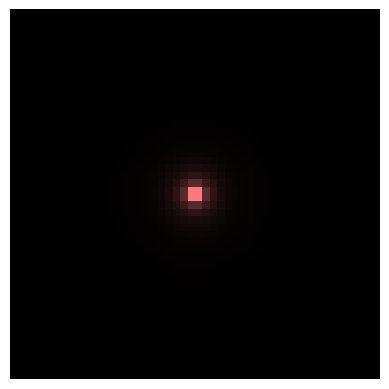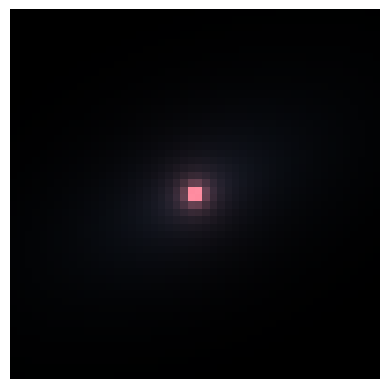Generate composite galaxy¶
Finall, in this example we’re going to demonstrate how to make a composite galaxy, including with imaging. For more information on defining parametric morphology see the Imaging examples.
[1]:
import numpy as np
from unyt import Msun, Myr, angstrom, kpc
from synthesizer.emission_models import IncidentEmission
from synthesizer.filters import UVJ
from synthesizer.grid import Grid
from synthesizer.parametric import SFH, Stars, ZDist
from synthesizer.parametric.galaxy import Galaxy
from synthesizer.parametric.morphology import Sersic2D
/tmp/ipykernel_6762/2794591620.py:5: FutureWarning: The filters module has been moved to the instruments module. Please update your imports synthesizer.filters -> synthesizer.instruments
from synthesizer.filters import UVJ
Let’s begin by defining the geometry of the images:
[2]:
# Define geometry of the images
resolution = 0.1 * kpc # resolution in kpc
npix = 50
fov = resolution * npix
And initialising the Grid object:
[3]:
grid_name = "test_grid"
grid = Grid(grid_name, new_lam=np.logspace(3, 4.2, 1000) * angstrom)
/tmp/ipykernel_6762/2110318097.py:2: RuntimeWarning:
The following lines are outside the wavelength range of the grid: [np.str_('Fe 2
1.59948m'), np.str_('Fe 2 1.64355m'), np.str_('Fe 2 1.66377m'), np.str_('Fe 2
1.67688m'), np.str_('Fe 2 1.71113m'), np.str_('Fe 2 1.74494m'), np.str_('Fe 2
1.79711m'), np.str_('Fe 2 1.80002m'), np.str_('Fe 2 1.80940m'), np.str_('H 1
1.87510m'), np.str_('Fe 2 1.89541m'), np.str_('Ni 2 1.93877m'), np.str_('Fe 2
1.95361m'), np.str_('Si 6 1.96247m'), np.str_('H 1 2.16553m'), np.str_('Si 7
2.48071m')]
grid = Grid(grid_name, new_lam=np.logspace(3, 4.2, 1000) * angstrom)
And initialising a FilterCollection, in this case the rest-frame UVJ filters.
[4]:
filters = UVJ(new_lam=grid.lam)
Disk¶
Let’s now build the disk component of our composite galaxy.
Starting by defining the morphology:
[5]:
morph = Sersic2D(
r_eff=2.0 * kpc, sersic_index=1.0, ellipticity=0.5, theta=35.0
)
Define the parameters of the star formation and metal enrichment histories
[6]:
sfh_p = {"max_age": 10 * Myr}
Z_p = {
"log10metallicity": -2.0
} # can also use linear metallicity e.g. {'Z': 0.01}
stellar_mass = 10**9.5 * Msun
Define the functional form of the star formation and metal enrichment histories
[7]:
sfh = SFH.Constant(**sfh_p) # constant star formation
metal_dist = ZDist.DeltaConstant(**Z_p) # constant metallicity
Get the 2D star formation and metal enrichment history for the given SPS grid. This is (age, Z).
[8]:
stars = Stars(
grid.log10age,
grid.metallicity,
sf_hist=sfh,
metal_dist=metal_dist,
initial_mass=stellar_mass,
morphology=morph,
)
/opt/hostedtoolcache/Python/3.10.19/x64/lib/python3.10/site-packages/unyt/array.py:1832: RuntimeWarning: divide by zero encountered in log10
out_arr = func(np.asarray(inp), out=out_func, **kwargs)
Initialise the Galaxy object, make an image and plot it. In this case, we can make a colour image using our UVJ filters:
[9]:
# Initialise Galaxy object
disk = Galaxy(stars=stars)
# Generate stellar spectra
incident = IncidentEmission(grid)
disk.stars.get_spectra(incident)
# Get photometry
disk.get_photo_lnu(filters)
# Make images
disk_img = disk.get_images_luminosity(
resolution=resolution,
fov=fov,
emission_model=incident,
)
print(disk)
# Make and plot an rgb image
disk_img.make_rgb_image(rgb_filters={"R": "J", "G": "V", "B": "U"})
fig, ax, _ = disk_img.plot_rgb_image(show=True)
+-----------------------------------------------------------------------------+
| GALAXY |
+-------------+---------------------------------------------------------------+
| Attribute | Value |
+-------------+---------------------------------------------------------------+
| galaxy_type | 'Parametric' |
+-------------+---------------------------------------------------------------+
| stars | <synthesizer.parametric.stars.Stars object at 0x7f5bba9a0490> |
+-------------+---------------------------------------------------------------+
| name | 'parametric galaxy' |
+-------------+---------------------------------------------------------------+
/home/runner/work/synthesizer/synthesizer/src/synthesizer/utils/ascii_table.py:65: FutureWarning: The `photo_fluxes` attribute is deprecated. Use `photo_fnu` instead. Will be removed in v1.0.0
self.attributes[name] = getattr(obj, name)
/home/runner/work/synthesizer/synthesizer/src/synthesizer/utils/ascii_table.py:65: FutureWarning: The `photo_luminosities` attribute is deprecated. Use `photo_lnu` instead. Will be removed in v1.0.0
self.attributes[name] = getattr(obj, name)

Bulge¶
Lets do the same but make a Bulge this time to combine.
[10]:
# Define bulge morphology
morph = Sersic2D(r_eff=0.5 * kpc, sersic_index=4.0)
# Define the parameters of the star formation and metal enrichment histories
stellar_mass = 10**9.2 * Msun
stars = Stars(
grid.log10age,
grid.metallicity,
sf_hist=10.0 * Myr,
metal_dist=0.01,
morphology=morph,
initial_mass=stellar_mass,
)
# Get galaxy object
bulge = Galaxy(stars=stars)
# Get spectra
bulge.stars.get_spectra(incident)
# Get photometry
bulge.get_photo_lnu(filters)
# make images
bulge_img = bulge.get_images_luminosity(
resolution=resolution,
fov=fov,
emission_model=incident,
)
# Make and plot an rgb image
bulge_img.make_rgb_image(rgb_filters={"R": "J", "G": "V", "B": "U"})
fig, ax, _ = bulge_img.plot_rgb_image(show=True)

Total¶
Finally we can combine the disk and bulge together to make a composite galaxy.
[11]:
# Combine galaxy objects
combined = disk + bulge
print(combined)
# Combine images
total = disk_img + bulge_img
# Make and plot an rgb image
total.make_rgb_image(rgb_filters={"R": "J", "G": "V", "B": "U"})
fig, ax, _ = total.plot_rgb_image(show=True)
+-----------------------------------------------------------------------------+
| GALAXY |
+-------------+---------------------------------------------------------------+
| Attribute | Value |
+-------------+---------------------------------------------------------------+
| galaxy_type | 'Parametric' |
+-------------+---------------------------------------------------------------+
| stars | <synthesizer.parametric.stars.Stars object at 0x7f5bb94874c0> |
+-------------+---------------------------------------------------------------+
| name | 'parametric galaxy' |
+-------------+---------------------------------------------------------------+

And plot the spectra for good measure…
[12]:
from synthesizer.emissions import plot_spectra
plot_spectra(
spectra={
"Combined": combined.stars.spectra["incident"],
"Disk": disk.stars.spectra["incident"],
"Bulge": bulge.stars.spectra["incident"],
},
show=True,
ylimits=(10**29.0, 10**31.0),
xlimits=(900, 10**4.3),
figsize=(6, 5),
)

[12]:
(<Figure size 600x500 with 1 Axes>,
<Axes: xlabel='$\\lambda/[\\mathrm{\\AA}]$', ylabel='$L_{\\nu}/[\\mathrm{\\rm{erg} \\ / \\ \\rm{Hz \\cdot \\rm{s}}}]$'>)